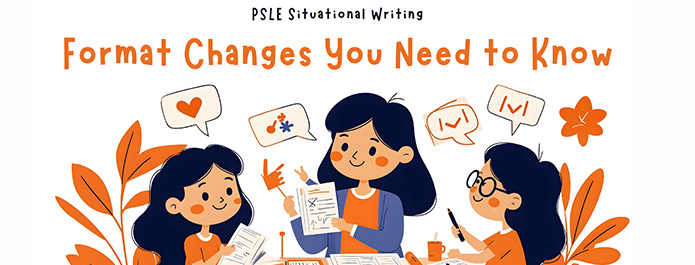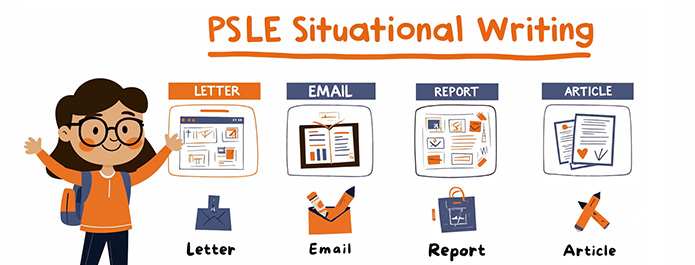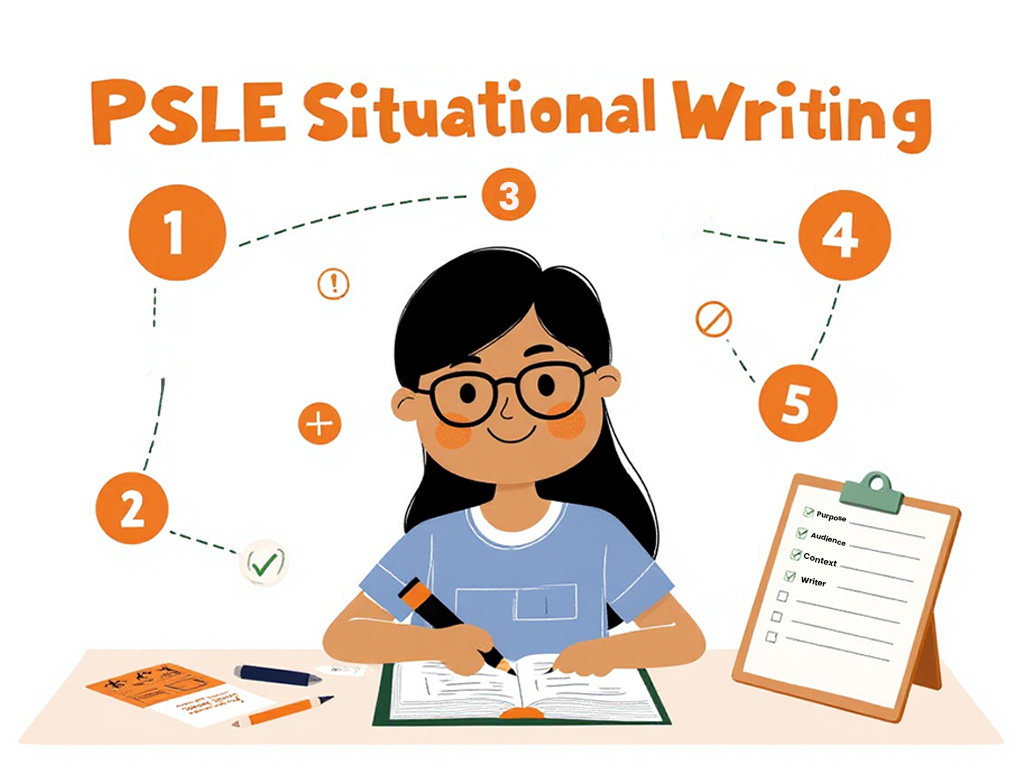As your child progresses through Primary 5, they'll encounter a crucial component that becomes increasingly important for PSLE English success: Situational Writing. This essential skill, worth 14 marks in Paper 1, can make or break your child's English Language results. Understanding its significance early and building strong foundations during P5 gives students the confidence and competency needed to excel when it matters most.
Situational Writing tests real-world communication skills that students will use throughout their academic journey and beyond. Unlike creative composition writing, this component requires students to write functional pieces like letters, emails, reports, and articles for specific purposes and audiences. The 2025 changes have introduced critical thinking elements that demand even more strategic preparation, making early mastery essential for PSLE success.
What's New in 2025: Format Changes You Need to Know

Based on the official SEAB syllabus document and confirmed updates from education providers, the 2025 PSLE Situational Writing component includes several important changes:
Previous Format | 2025 CONFIRMED | Impact on Students |
|---|---|---|
15 marks total | 14 marks total ✓ | Each error costs more marks |
Language: 9 marks | Language: 8 marks ✓ | Higher accuracy demands |
All content points from stimulus | 1 content point requires original thinking ✓ | Critical thinking skills essential |
3 formats: Letter, Email, Report | 4 formats: Letter, Email, Report, Article ✓ | New engaging writing style to master |
Sources: SEAB PSLE English Language Syllabus 2025 and confirmed by established education providers. For the most current information, please refer to the Singapore Examinations and Assessment Board (SEAB).
Critical Thinking Component (Confirmed for 2025)
The most significant change is the introduction of a critical thinking element. Out of the 6 content points required for task fulfilment in situational writing:
- 5 content points can be found directly in the visual stimulus
- 1 content point will be underlined and requires original thinking
- Students must come up with logical, relevant ideas using critical thinking skills in the PSLE
- Multiple acceptable answers are possible for this inference point
Task fulfilment is crucial in situational writing, as students must fully address all required content points and adhere to task instructions to achieve full marks.
Examples of critical thinking points:
- “How you intend to update your friend about missed classwork”—students need to come up with a suitable way to inform their friend in the PSLE
- “One way participating in the charity drive will benefit you and your friend”—students are expected to come up with original, relevant suggestions in the PSLE
- “Possible challenges volunteers may face when tutoring disadvantaged children”—students should come up with logical challenges based on the scenario in the PSLE
This change encourages students to think beyond the given information and demonstrate analytical reasoning skills. A strong understanding of the scenario and requirements in situational writing is essential for success.
Understanding Format Types and Requirements

Format Overview Table
Format | When to Use | Key Features | Tone Options |
|---|---|---|---|
Letter | Traditional formal communication | Full address format required | Formal/Informal |
Modern digital communication (most common) | Subject line, simplified format | Formal/Informal | |
Report | Official documentation or updates | Subject line, structured body | Always formal |
Article | Public sharing in magazines/newsletters/websites ✓ | Engaging headline, lively tone | Usually engaging/persuasive |
Note: Article writing is now confirmed as a new format for 2025, requiring more engaging and persuasive writing styles for wider audiences.
The PACW Strategy: Your Systematic Approach
Before writing, analyze every question using PACW. Understanding the purpose, audience, and context is essential for meeting the requirements of any writing task.
P | Purpose | Why are you writing? (inform, invite, complain, recommend) |
|---|---|---|
A | Audience | Who are you writing to? (friend, teacher, authority figure) |
C | Context | What’s the situation? (formal meeting, casual event, urgent matter) |
W | Writer | What’s your role? (student, team member, concerned citizen) |
Always consider the purpose, audience and context to ensure your response is targeted and effective. Carefully check the task box for key information about the purpose, audience, and context before you start writing.
Quick PACW Analysis Examples
Scenario: Write to your friend about a school fundraising event
- P: Invite participation and inform about details
- A: Close friend (informal tone appropriate)
- C: School event (semi-formal context)
- W: Fellow student and friend
Scenario: Write to the principal about a facility problem
- P: Report issue and request action
- A: School authority figure (formal tone required)
- C: Official complaint/request
- W: Concerned student
Formal vs Informal Writing: Key Differences
Language and Tone Comparison
Aspect | Formal Writing | Informal Writing |
|---|---|---|
Contractions | Avoid (do not, cannot, will not) | Allowed (don't, can't, won't) |
Exclamation marks | Avoid or use sparingly | Can use for enthusiasm |
Greetings | "Dear Sir/Madam" | "Hi!" or "How are you?" |
Vocabulary | Professional, precise | Conversational, friendly |
Sentence structure | Complete, formal constructions | Can be more relaxed |
Common Formal vs Informal Phrases
Purpose | Formal Writing | Informal Writing |
|---|---|---|
Stating purpose | "I am writing to inform you..." | "I wanted to tell you about..." |
Making requests | "I would be grateful if you could..." | "Could you please..." |
Expressing urgency | "This matter requires immediate attention" | "This is really important!" |
Closing thoughts | "I look forward to your prompt response" | "Hope to hear from you soon!" |
Content Points Mastery: The 6-Point System
Content Point Strategy
- 1Read carefully and identify all 6 content points
- 2Number each point in the question
- 3Highlight relevant details in the visual stimulus
- 4Identify the inference point (underlined in 2025)
- 5
Plan your response for each point
- 6Check coverage before submitting
Sample Content Points Breakdown
Scenario: Inviting a friend to a school carnival
Point | Requirement | Response Strategy |
|---|---|---|
1 | Event name and date | Extract directly from stimulus |
2 | Venue and time | Find in visual materials |
3 | Activities available | List from provided information |
4 | Entry requirements | Check stimulus for details |
5 | Why friend should attend | Inference point - create compelling reasons |
6 | How to respond | Provide clear instructions |
Time Management: The 20-Minute Formula
Optimal Time Allocation
Phase | Duration | Activities |
|---|---|---|
Planning | 5 minutes |
|
Writing | 10 minutes |
|
Review | 5 minutes |
|
Common Mistakes and How to Avoid Them

Critical Error Categories
Error Type | Common Mistakes | Prevention Strategy |
|---|---|---|
Format |
|
|
Content |
|
|
Language |
|
|
Quick Error-Prevention Checklist
Before Writing:
- PACW analysis completed
- All 6 content points identified
- Inference point planned
- Format choice confirmed
After Writing:
- All content points addressed
- Format elements corrected
- Tone consistent throughout
- Grammar and spelling checked
Master PSLE Situational Writing With Keynote Learning

At Keynote Learning, we understand that PSLE Situational Writing success requires more than just knowing the formats. Our comprehensive English tuition program helps students develop the critical thinking skills, systematic approaches, and confidence needed to excel in this challenging component.
Why Choose Keynote Learning?
Our Unique Strengths:
Strong Individual Focus: Personalised attention for each student's specific needs and learning pace
Exceptional Tutors: Years of PSLE experience combined with innovative, engaging teaching methods
Life Skills Development: Beyond academics, we build essential communication and critical thinking abilities
Exclusive Student Resources:
ThinkInn Learning Platform: 24/7 access to expert-curated materials
On-Demand Video Recaps: Review concepts anytime, anywhere
Comprehensive Practice Bank: Extensive scenarios covering all question types
Ready to give your child the advantage they need for PSLE Situational Writing success? Learn more about our comprehensive PSLE English tuition and discover how our proven methods can help your child achieve their full potential in English Language.
Contact Keynote Learning today to find out how our exceptional support and innovative teaching approaches can make the difference in your child's PSLE preparation journey.

